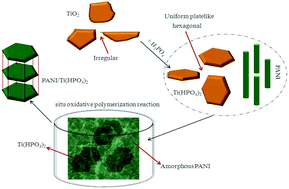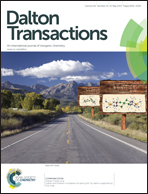Synthesis of a novel organic–inorganic hybrid of polyaniline/titanium phosphate for Re(vii) removal†
Abstract
The organic–inorganic hybrid material of polyaniline/titanium(IV) (PANI/Ti(HPO4)2) was synthesized by an oxidative polymerization reaction. The PANI/Ti(HPO4)2 was applied to remove Re(VII). The size of Ti(HPO4)2 nanoplates has no obvious effect on the sorption capacity. The effects of various environmental factors (such as pH, extra anions (NO3− and MO42−) and temperature) on Re(VII) sorption to PANI/Ti(HPO4)2 were investigated by batch experiments. The sorption kinetics followed a pseudo-second-order model. The nitrogen-containing functional groups of PANI promoted Re(VII) sorption. The PANI/Ti(HPO4)2 exhibited excellent maximum sorption capacity to Re(VII) (47.62 mg g−1), which was superior to that of PANI (10.75 mg g−1) and much higher than that of many other sorbents. The sorption isotherms of Re(VII) can be well fitted with the Langmuir model. Re(VII) sorption decreased with increasing solution pH at pH > 4.0, which implied that Re(VII) sorption on PANI/Ti(HPO4)2 might be attributed to the outer-sphere complexation between amine and imine groups on the surface of PANI/Ti(HPO4)2 and Re(VII). This study implies that the hybrid material of PANI/Ti(HPO4)2 can be regarded as a potential sorbent to remove Re(VII) and its analogues from large volumes of aqueous solutions.


 Please wait while we load your content...
Please wait while we load your content...